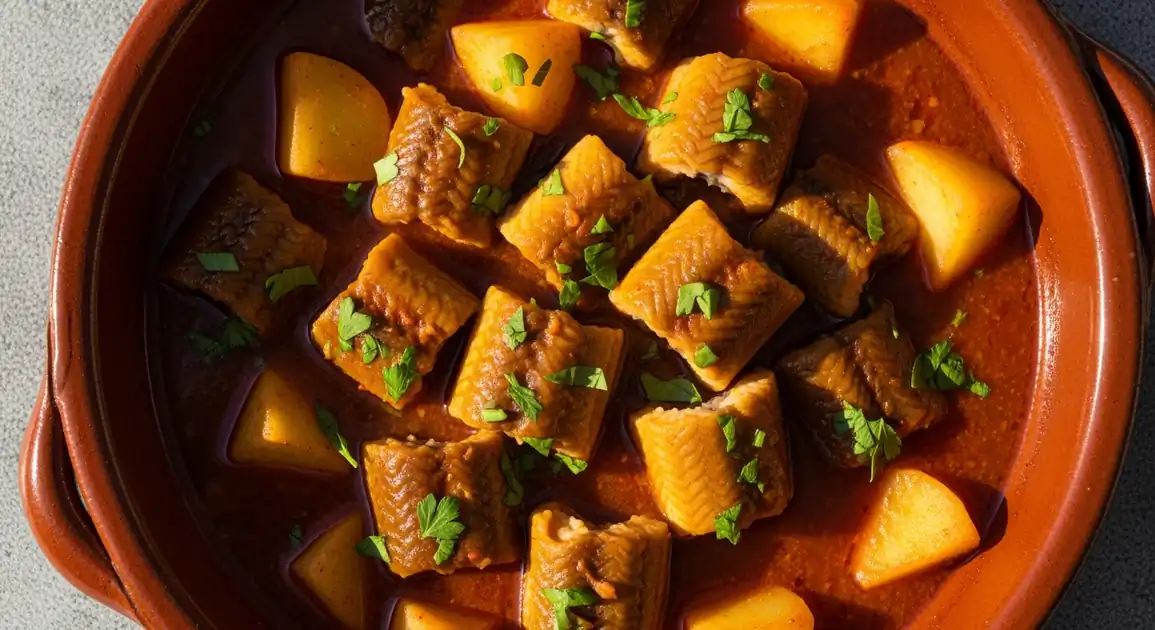All-i-pebre
All-i-pebre

Description
All-i-pebre is primarily a Valencian dish, mostly found in the autonomous community of Valencia in eastern Spain. While it can occasionally appear in Spanish restaurants elsewhere in the country, its true home is Valencia, particularly around Albufera Lake where it originated. Outside this region, it's relatively uncommon on regular menus, though specialized Valencian restaurants nationwide might offer it.
Dietary Information
Serving information
Serving style
Typically served in a clay cazuela (earthenware dish) to maintain heat, accompanied by crusty bread for soaking up the sauce. Usually served as a main course, though some restaurants may offer a smaller portion as a starter.
Quick facts
Lunch: 1:30 PM - 4 PM, Dinner: 8:30 PM - 11 PM, following standard Spanish dining hours. Note that many traditional restaurants in smaller towns may close between meals.
Safety Tips
What to Look For
-
Eel that is white to slightly pinkish when cooked
Properly cooked eel should have firm, opaque flesh. If it appears translucent, it may be undercooked.
-
Sauce with a rich, homogeneous texture
A good All-i-pebre sauce should be thick enough to coat the back of a spoon, indicating proper reduction and cooking time.
-
Dish served piping hot in a traditional clay cazuela
Ensures proper cooking temperature and maintains the traditional serving style that keeps the dish hot throughout the meal.
-
Restaurant displays knowledge about the source of their eel
Quality establishments will know if their eel is from Albufera, other Spanish waters, or farm-raised, indicating attention to ingredients.
What to avoid
-
Very fishy smell or gray-colored eel
Fresh eel should not have an overpowering fishy odor. Gray coloration could indicate old or poorly handled eel.
-
Watery or separated sauce
Indicates improper cooking technique or rushed preparation.
-
Undercooked or rubbery eel
Eel must be thoroughly cooked for both safety and texture reasons. It should flake easily when pressed with a fork.
-
Pre-prepared All-i-pebre that's merely reheated
The best versions are made to order or at least freshly prepared that day. Ask if in doubt.
Price information
Price range
Budget tips
- Prices are generally lower in El Palmar and villages around Albufera than in Valencia city center.
- Lunch menus ('menú del día') sometimes include All-i-pebre as a main course option, offering better value than ordering à la carte.
- Restaurants further from tourist areas tend to offer more reasonable prices.
Value indicators
- Generous portion size with ample sauce.
- Good ratio of eel to potatoes (more eel indicates better value).
- Freshness of the eel.
- Richness and complexity of the sauce.
- Complementary bread served alongside.
Where to Find This Dish
Coastal Areas
Fishing villages and towns along the Valencian coast often serve excellent All-i-pebre.
Mediterranean coastline, Fishing ports
Lunch, Early Dinner
Major Cities
Found in traditional restaurants in Valencia, Alicante, and other major cities in the region.
Historic centers, Valencian cuisine restaurants
Lunch, Dinner
Rural Areas
Some inland restaurants offer All-i-pebre, though often with adaptations if fresh eel is less available.
Country restaurants, Rural hotels
Weekend Lunch
Vendor Tips
- Restaurants displaying 'Cocina Valenciana Tradicional' (Traditional Valencian Cuisine) are more likely to serve authentic All-i-pebre.
- Ask if they use freshwater eel from Albufera or at least Spanish-sourced eel.
- Check if the dish is prepared to order rather than pre-made.
How to Order
Regional Variations
-
Traditional All-i-pebre with Eel
(All-i-pebre Tradicional con Anguila)
The classic version made with freshwater eel from Albufera Lake, featuring garlic, paprika, olive oil, and potatoes in a rich sauce.
-
All-i-pebre with Monkfish
(All-i-pebre de Rape)
A popular coastal variation using monkfish instead of eel, often preferred by those who find eel too rich or aren't accustomed to it.
-
All-i-pebre with Cod
(All-i-pebre de Bacalao)
A variation using desalted cod, creating a different texture while maintaining the traditional sauce.
-
Spicy All-i-pebre
(All-i-pebre Picante)
Features additional hot paprika or chili peppers for those who prefer a spicier dish.
-
All-i-pebre with Cuttlefish
(All-i-pebre de Sepia)
A variation using cuttlefish instead of eel, popular in coastal areas south of Valencia.
Cultural context
History
All-i-pebre originated in the fishing communities surrounding Valencia's Albufera Lake, where freshwater eels were abundant. Dating back several centuries, it was a practical way for fishermen to prepare their catch using readily available ingredients. The dish represents the region's connection to both the sea and the fertile land around it. While traditionally a humble fisherman's meal, All-i-pebre has evolved into one of Valencia's most celebrated culinary specialties, proudly served in restaurants throughout the region as a symbol of Valencian cultural identity.
Local significance
All-i-pebre represents Valencia's unique culinary heritage that blends inland and coastal influences. It's a source of regional pride and considered an essential taste of authentic Valencian gastronomy.
Eating customs
- Using bread to soak up the sauce is not just acceptable but expected.
- The dish is meant to be shared, often served in a communal cazuela.
- It's typically paired with local white wines from Valencia region.